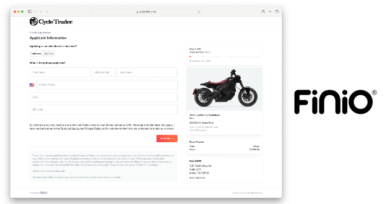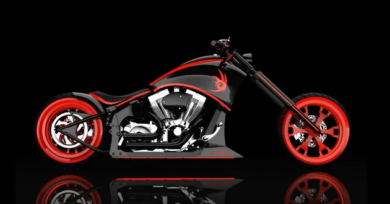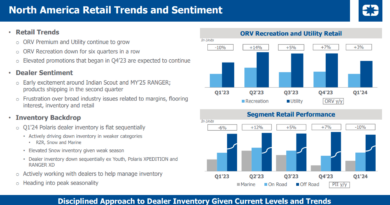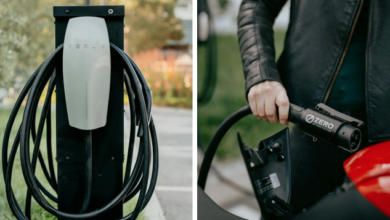March 13, 2006 – Viewpoints on a debated issue in Indy
The proposed resolution as given to the mic:
The Motorcycle Industry Council recognizes the consuming public is best served by the regulated distribution of motorcycles, ATVs and off-road vehicles, and supports the enactment of legislation and administrative rules requiring importers, distributors and dealers be registered and licensed by the states in which they are sold. It is further resolved that all ATVs and off-road vehicles be registered to the ultimate consumer by licensed dealers registering the product with appropriate state authorities and the manufacturer, importer or distributor who has appointed the dealer. Licensed dealer, manufacturer, importer or distributor to be required to send notice to consumer of any safety-related recall and that licensed dealers be able to provide parts and services required to comply with safety recall, and that the licensed dealer be able to provide instruction on the appropriate and safe use of the product.
The resolution shown above was not adopted by the MIC as written. At the General Business Annual Meeting, President Tim Buche read a statement broadly affirming the general principles of the resolution. Later at the Board of Directors meeting, the resolution in its entirety was presented and considered by the board.
I sincerely appreciate all of the courtesy extended. I was given ample opportunity to present my views and those of the National Council of Motorcycle Dealer Associations. The message was well received and discussed at length by the board.
In the end, the MIC Board felt that they could not give us a carte blanche preamble for any measure we chose to introduce to a state legislative or administrative body.
What they did do was fully affirm the concept of enforcing the traditional means of product distribution at the state level, and pledged to support any dealer association initiative to do so.
I will provide a bit of a history lesson and justification for the resolution and the need for MIC to support the state dealer associations on this one.
Our industry is now 37 years old. I know there have been motorcycles for around 110 years, but truly the U.S. motorcycle industry began in 1969, with the formation of the Motorcycle Industry Council.
Prior to that there were people manufacturing, importing, distributing and retailing motorcycles, but you could not call it an industry. No one spoke for the industry and we sure missed the boat on some key federal legislation in the 1960s, like the wage and hour bill, which caused the federal government to lump us in the “retail other” category. Nearly every other category of “dealer” gets much more favorable treatment to this day.
In 1970, the OEMs, led by Dick Orth (Suzuki), Matt Matsuoka (Honda) Terry Tiernan (Yamaha), Don Graves (Kawasaki) and John Harley (yes, that Harley), recognized a priority for the industry was the establishment of state dealer associations to address a myriad of adverse legislation states were enacting in reaction to the booming sales of low-priced Japanese imports. At the time I was a district manager for U.S. Suzuki, covering Washington, Oregon, Idaho and Montana. We had clear marching orders: sign your dealer up for the MIC.
There was great unity in the industry as all levels recognized the success and growth of the industry was dependent on credible and rational information being provided to state legislatures and regulatory bodies. All district managers in the industry went door to door collecting $160 checks, $100 for the state association and $60 for the MIC. Lest you think the amount was small, the top sellers of the day retailed for $599 or less. Massive state gatherings were sponsored by the big four Japanese OEMs and Harley.
In the 35 years since, the industry has seen nothing like it.
I remember Gene Troubaugh, Don Graves and Sam Carona taking the stage, while Joe Ramos, Bill Erickson and myself worked the floor and aisles getting everyone signed up. That was the scene in the Northwest and it was repeated around the country. We came together and became an industry.
At the time, the presence of motorcycles in the marketplace was a lot different than it is today. My biggest dealer in Seattle was a bicycle shop and in Tacoma, Suzukis were sold out of the basement of Paulson’s furniture shop. I had several dealers in feed stores, gas stations, tractor dealerships, one in a restaurant and my all-time favorite, Burns Brothers Funeral Home and Suzuki in Cut Bank Montana.
Today the motorcycle dealership has a totally different presence in the marketplace. It is not uncommon today to drive into a town and find that a big box motorcycle dealership is the most dominant retail store in a premier location. The growth from 1970 to now was certainly not smooth, with some battles being fought within the industry, as well as with forces from outside. The crisis we face today with the unregulated sale of cloned product is one of many dealers have had to deal with in our short history as an industry.
In 1974, the state association presidents, under the auspices of the MIC, met in Atlanta to share experiences. At the time, I was a Suzuki/Honda dealer and president of the Oregon Dealers Association. The conversation quickly turned to franchise protection and the legislation auto dealers were introducing in their states. It was decided to do some research and meet again later in the year in Monterey, Calif. Our research showed we were experiencing the same sort of problems the auto dealers were and that clearly the pending legislation needed to include motorcycle dealers.
OEMs in the MIC began to feel there was clear conflict of interest and expelled dealers from the MIC. In November of 1984, we formed the National Motorcycle Dealership Association, on which I served as a charter director and later chairman. In its short existence, the national association did draft model franchise protection legislation that was enacted in most states. Today, the only motorcycle dealers in the world with franchise protection are in the United States. It has made the franchises more valuable and the protection has encouraged dealers to provide the presence we now have in the marketplace.
For most dealers today, ATVs and off-road vehicles comprise more than 50 percent of their total sales. The facilities, staff and promotional resources they provide, which have driven the industry to its current level, would not exist without the off-road business. The attack on that segment of the industry is very real. The cloned product coming in today may not pose a great threat, but that is what Triumph and BSA dealers said in the 1960s. The new Asian product will get better and the supplies will increase.
For all the reasons listed in the resolution, we need to welcome the new arrivals, and level the playing field. Perhaps this crisis can act as the catalyst to bring the industry together again. Our problem always has been that whatever characteristics drive someone to become a motorcycle dealer seem to push out a desire to join anything.
It is time to stop allowing petty issues from keeping you from joining state dealer associations. If you do not have an association, the national council will help you form one as we did in December in Georgia and will in March in Oklahoma.
Yes, there were conflicts in the past, and OEMs and dealers might not be aligned on issues in the future. We all need to come together on this one.
A word to my Harley-Davidson dealer friends. This crisis may not impact you; will the next one? If the current crisis makes your state dealer association stronger, your position is enhanced. Please do not watch from the sidelines feeling this is not your problem. The solution is very much in your interest. psb
The opinions expressed in this column are not necessarily those of the publisher.




